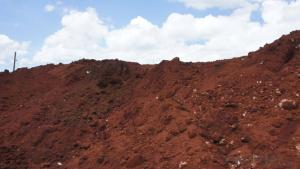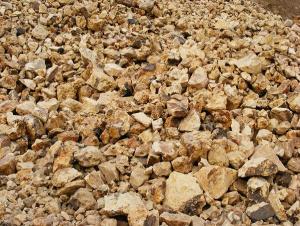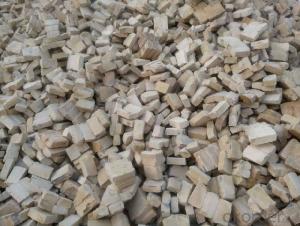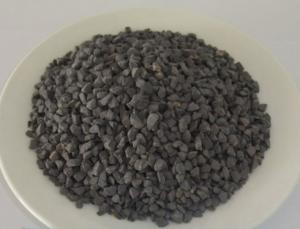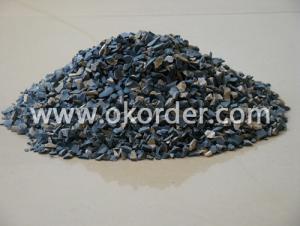Bauxite Material Sand Brown Fused Alumina of CNBM in China
- Loading Port:
- Tianjin
- Payment Terms:
- TT or LC
- Min Order Qty:
- 25 m.t.
- Supply Capability:
- 3000 m.t./month
OKorder Service Pledge
OKorder Financial Service
You Might Also Like
Bauxite Material Sand Brown Fused Alumina of CNBM in China
1.Structure of Calcined Bauxite Description
calcined bauxite is one of the principal ore of aluminum. Calcined bauxite contains hydrous aluminum oxides and
aluminum hydroxides, formed through the laterization of aluminous rocks in tropical and subtropical areas .
calcined bauxite is obtained by calcining (heating)superior grade bauxite at high temperature (from 85OC to 1600C) .this removes moisture thereby increasing the
alumina content. compared to an alumina content of about 57%to 58%in raw bauxite, calcined bauxite has an alumina content of 84% to 88%.the heating is carried out in rotary kilns.
2.Main Features of the Calcined Bauxite
Calcined bauxite is one of the principal ore of aluminum. Calcined bauxite contains hydrous aluminum oxides and aluminum
hydroxides, formed through the laterization of aluminous rocks in tropical and subtropical areas .Calcined bauxite is obtained by calcining (heating)superior grade bauxite at high temperature (from 85OC to 1600C) .This removes moisture there. By increasing the alumina content,compared to an alumina content of about 57%to 58% in raw bauxite, calcined bauxite has an alumina content of 84%to88%.The heating is carried out in rotary kilns.
3.Main usage of the Calcined Bauxite
(1) aluminium industry. Used in national defense, aerospace, automotive, electronics, chemical industry, daily necessities, etc.
(2) precision casting. Alumina clinker made after the mould precision casting processed into fine powder. Used in military industry, aerospace, communications, instrumentation, machinery and medical equipment department.
(3) is used for refractory products. High bauxite clinker refractoriness is as high as 1780, chemical stability strong, and good physical properties.
(4) aluminum silicate refractory fiber. With light weight, high temperature resistance, good thermal stability, low thermal conductivity, heat capacity is small and the advantages of resistance to mechanical shock. Used in iron and steel, nonferrous metallurgy, electronics, petroleum, chemical, aerospace, atomic energy, defense and other industries.
(5) in magnesia and bauxite clinker as raw materials, add the appropriate binder, used for pouring ladle whole ladle lining has particularly good effects.
(6) manufacture alumina cement, abrasive materials, ceramic industry and chemical industry can be aluminum of various compound.
4. Calcined Bauxite Images

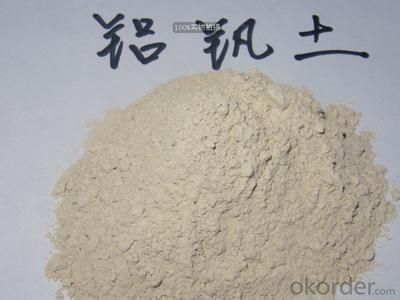
5. Calcined Bauxite Specification
| Place of Origin: | Henan, China (Mainland) | Shape: | Powder, macrogrit | Material: | alumina |
| SiO2 Content (%): | 1.2% | Al2O3 Content (%): | 95.65% | MgO Content (%): | 0 |
| CaO Content (%): | 0 | Refractoriness (Degree): | 1770°< Refractoriness< 2000° | CrO Content (%): | 0 |
| SiC Content (%): | 0 | Model Number: | brown fused alumina, all models | Brand Name: | CNBM |
| Name: | Bauxite Material sand brown fused alumina | Application: | grinding,wire cutting,refractory,buffering | Micro hardness: | HV1800-2200kg/m2 |
| Refractoriness: | 1963 | alumina: | 99.5%min | Fe2O3: | 0.1% |
| TiO2: | 2.3% | toughness: | great |
6.FAQ of Calcined Bauxite
1). Q: Are you a factory or trading company?
A: We are a factory.
2). Q: Where is your factory located? How can I visit there?
A: Our factory is located in ShanXi, HeNan, China. You are warmly welcomed to visit us!
3). Q: How can I get some samples?
A: Please connect me for samples
4). Q: Can the price be cheaper?
A: Of course, you will be offered a good discount for big amount.
- Q:What is required to do refractory material?
- Can you be more specific about what aspect?
- Q:what needs to be noted when choosing and using blast furnace fireproof materials?
- it depends on the size of the blast furnace. below 200 cubic meters alumina bricks and carbon brickcan be used. 200 cubic meters and above are currently integrated bottom, not the same as the size of the cubic level, varying in the use of refactory. I hope my answers above are helpful to you and your ideal anwers.
- Q:What are the main characteristics of the sic refractories?
- 1. The usge temperature of silicon carbide refractory is generally 1760 ℃ 2. The silicon carbide refractories can withstand the dramatic changes of temperature and have a good thermal shock resistance performance. To prevent the cracking or breaking of lining refractories. 3. Under the conditions of high or low temperature, it can withstand a certain compressive stress. 4. Under the conditions of high or low temperature, it can withstand friction. 5. It can withstand the huge hydraulic pressure or buoyancy of the metal. 6. It can also withstand the effect of furnace gases to prevent the infiltration of other refractories and reactions.
- Q:How to choose construction external wall thermal insulation and fireproofing materials?
- The width of fireproof partition shuld be greater than 30CM, and the thickness should be the same as total thickness of thermal insulation materials. Fire barrier zone thermal insulation board and base wall should be stuck in whole area. Fire Barrier zone thermal insulation board should be stuck with the assistance of anchor bolt which must press the mesh of the bottom layer. Fire Barrier zone should be set above the door and window, with a distance of less than 50cm between the lower edge of fire barrier zone and the upper edge of window.
- Q:What things and cement mixed can act as refractory?
- Cement building, portland cement, refractory grade, calcium aluminate. Cement acts as refractory need to use calcium aluminate cement.
- Q:Who knows about roof fireproofing materials?
- At present, only phenolic foam boards can meet requirements. The test temperature can be 2,000 degrees, and there is no molten droplet during the tests and it can maintain integrity. heat conductivity coefficient: 0.03W / (mk), non-combustible, non-toxic, smokeless!
- Q:Can anyone tell me what is a high alumina refractory?
- Refractories refer to a class of inorganic non-metallic materials whose refractoriness are no less than 1580 ℃. Refractoriness is the Celsius temperature when cone-shaped samples can resist high temperature without softening and melting down in the absence of a load. But it is not accurate to define refractory merely by judging that whether the refractoriness is no less than 1580 ℃. Currently, the materials whose physical and chemical properties allow them to be used in high temperature environments are called refractories. Refractory materials are widely used in metallurgy, chemical industry, petroleum, machinery manufacturing, power and so on, among which the metallurgical industry is the largest demander in this regard, accounting for 50% to 60% of total output. Hope it will help you out!
- Q:The classification of fire-resistant material
- Refractory material cna be divided into common and special fire proofing material. Common fire proofing material can be sub-divided in to acid fire proofing material, neutral fire proofing material. and alkaline fire proofing material according to chemical properties. Special fire proofing material can be divided into high temperature oxide refractory, refractory compounds and high temperature composite materials according to the composition. In addition, it also can be divided into common refractory products (1580 ~ 1770 ℃), high-grade refractory products (1770 ~ 1770 ℃) and super refractory products (above 2000 ℃) according to the strength . According to the shape, it can be divided into block (standard brick, special-shaped brick, etc.), special shape (crucible, sagger, pipe, etc.), fibrous (aluminum silicate, zirconia and boron carbide, etc.) and irregular shape (refractory clay, refractory castable, ramming material and so on). According to sintering process, it can be divided into sintered product, fused cast product and melting jetting product.
- Q:Which basic refractory is better?
- Zhengzhou Xindeyuan Refractories Co., Ltd.and Zhengzhou Rongsheng Kiln Refractories cO.,Ltd. Their basic refractories mainly refer to refractories with magnesium oxide and calcium oxide as main components what can resist errosion of basic slag, including magnesia bricks, magnesia-alumina bricks, magnesia-chrome bricks, dolomite?bricka and so on(magnesia bricks), among which magnesia bricks is the most common. Magnesia brick containing more than 80% to 85% magnesium oxide, has good resistance to basic slag and iron slag, and higher refractoriness than clay and silica brick. It is mainly used for open-hearth?furnace, oxygen-blown converter, electric furnace, ferrous metal smelting equipment and other high temperature equipments.
- Q:How many kinds of refractory materials are there in the EI?
- I suggest that you contribute articles to foreign SCI journals for the odds are better, and generally the articles that fill the bill will not be rejected. The traditional refractory materials can contribute to EI journal. If being rejected by EI journal, you can also contribute to Russia's journal Industrial Ceramics and Refractories. I didn't contribute to the Journal of Wuhan University of Science and Technology, the receiving cycle is almost 3 to 4 months. Though the impact factor is low, domestic EI journal is not so good, it is still SCI journal. This is my own experience, please take my advice. The best journals are the Journal of the American Ceramic Society and the Journal of the European Ceramic Society, I heard that they are not bad. But the best domestic EI refractory material journal is the Journal of The Chinese Ceramic Society. It is very long, but if it belongs to your university, it is another pair of shoes. Journals now all want to have materials about functional ceramics, and they don't want Chinese articles, if your English is not well enough, you can choose Ceramics International and Japan Ceramics but they have strict manuscripts reviewing standards.
1. Manufacturer Overview |
|
|---|---|
| Location | |
| Year Established | |
| Annual Output Value | |
| Main Markets | |
| Company Certifications | |
2. Manufacturer Certificates |
|
|---|---|
| a) Certification Name | |
| Range | |
| Reference | |
| Validity Period | |
3. Manufacturer Capability |
|
|---|---|
| a)Trade Capacity | |
| Nearest Port | |
| Export Percentage | |
| No.of Employees in Trade Department | |
| Language Spoken: | |
| b)Factory Information | |
| Factory Size: | |
| No. of Production Lines | |
| Contract Manufacturing | |
| Product Price Range | |
Send your message to us
Bauxite Material Sand Brown Fused Alumina of CNBM in China
- Loading Port:
- Tianjin
- Payment Terms:
- TT or LC
- Min Order Qty:
- 25 m.t.
- Supply Capability:
- 3000 m.t./month
OKorder Service Pledge
OKorder Financial Service
Similar products
New products
Hot products
Related keywords
